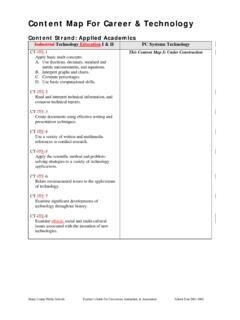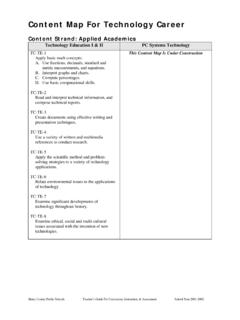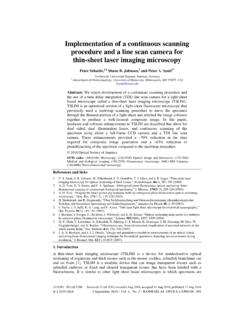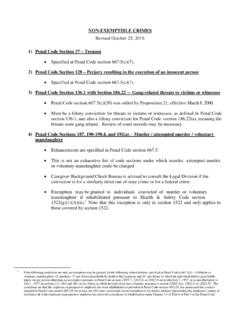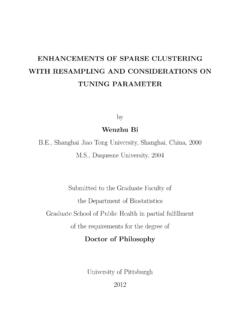Transcription of Optimizing OCR Accuracy on Older Documents: A Study of ...
1 Optimizing OCR Accuracy on Older Documents: A Study of scan Mode, File enhancement , and software products Jon M. Booth Jeremy Gelb Office of Innovation and New Technology Government Printing Office, Washington, DC revised June 2006 Background As part of the GPO s new Digital Conversion Services (DCS), we had been tasked to suggest methods to improve Optical Character Recognition (OCR) Accuracy rates on Older documents, evaluate the performance of these document enhancement techniques, and select an OCR software product . A minimum OCR Accuracy rate of 99% was established as a requirement by the Meeting of the Experts on Digital Preservation, and can be referenced in that document. This report gives a summary of the recommendations made, and a summary of the performance of the testing that we performed.
2 For the selection of an OCR software product , a Pugh Matrix was used. This tool allows a structured comparison of potential software products, based on a user-defined set of measurable attributes. A further refinement of this tool is the ability to define the relative level of importance for each attribute, using a system of weighting. The end result is a quantified product ranking, in which the top candidate is selected use in production. Several approaches can be used to evaluate the performance of file enhancement . The first approach would be to measure the Accuracy of the OCR output from the resulting image (for instance, average character Accuracy ). The second approach is much more subjective, which is to visually assess the performance of the enhancements.
3 Because the sole purpose of file enhancement is to improve OCR output Accuracy , the first approach will be used to measure the success of file enhancement . OCR software product Selection Before selecting the products to be tested, the attributes against which they would be measured have to be defined. The first attribute was the Accuracy requirement, provided by the Meeting of the Experts on Digital Preservation. Of course, with increased Accuracy , the product cost is expected to increase as well. Thus, the other initial attribute is the overall cost of the product . Attribute Refinement The initial pair of measure attributes is refined to reflect the varying components that make up each of these broad categories. The cost attribute is dissolved into 2 parts: Initial cost, and Total Cost of ownership (TCO).
4 The Accuracy attribute is defined as uncorrected Accuracy ; this will test the quality of the OCR conversion engines, without the included spell-checkers. Several other attributes need to be added as well, that aren t directly related to cost or Accuracy . Ease of Implementation and Ease of Use are 2 important attributes to consider for technology feasibility purposes. Processing Time (cycle time per page), and product Scalability are necessary to determine schedule feasibility and efficiency. Fig. 1 shows the Finalized list of attributes which are used to test the OCR products. Initial product Selection A listing of all the currently commercially available OCR software products first needs to be created. From this list, products can be eliminated based on non-compliance with our given list of product requirements.
5 Based on requirements for operating system compatibility, input file format, output file format, and price, the list was reduced to three software products. The remaining products are to be rigorously tested against the previously defined attributes. Baseline After the initial group of products is selected, one of the products is selected (at random) to be the baseline against which the others are compared. The selection of a particular product will not affect the outcome of the comparison results. Attribute Weighting The relative importance of the attributes in relation to each other can be established as well. This is not a required part of the Pugh selection tool, but it helps to strengthen the validity of the results, especially if the attributes are not of approximately equal importance.
6 See Fig. 2. The attributes are placed in rows and columns, allowing for direct comparison between each possible combination of attributes. An r is used if the row is more important, and a c is used for column. The number of r and c characters for each attribute are computed as a percentage of the total number of attribute combinations. Final Selection With all the input data in place, each product is compared to the baseline product , scoring it better, equal, or worse than the baseline product . In the case of the OCR software selection, a number scale of 1-5 is used, with 3 being equal to the baseline product . The data used to make these scorings are gathered from product literature, sales representatives, and internal product testing.
7 As Fig. 3 shows, the resultant scores for Products A, B, and C are shown in the bottom row of the table. product C is scored highest, followed by products A and B, respectively. Based on this data, product C is selected to be used for production within DCS. File enhancement Testing Processes Preparing the documents to be tested is a two-step process: physical material scanning and controlled file enhancement . The physical material is scanned according to DCS specifications, which state that a resolution of 400 dpi to be used for color and grayscale documents, and 600 dpi for bitonal documents. Initial Testing Unfortunately, the DCS scanning specifications can result in unacceptable scanned images, similar to the one shown on the left side of Fig. 4. Many Older documents such as Fig.
8 4 are completely unreadable when scanned in bitonal mode; others exhibit reduced readability and clarity of text. The result is significantly lower OCR Accuracy . Fig. 5 shows the comparison between bitonal, grayscale, and RGB scanning modes as they relate to OCR Accuracy for many Older documents. The resulting bitonal Accuracy is unacceptable; grayscale and color Accuracy rates are essentially equal. For this test, all images are scanned in RGB mode, because the scope of documents to which file enhancement will be applied are Older documents; these documents are yellowed, stained, wrinkled, and faded. Scanning these in RGB mode is the only way to capture this extra data, which can allow for further improvement of OCR Accuracy . See the bitonal vs.
9 Color scan comparison in Fig. 4. Additionally, more types of file enhancements are available to documents scanned in RGB mode than those scanned in a grayscale mode. File enhancement Selections The types of file enhancements to be tested are chosen from a list of all the available types of file enhancements possible; the initial selection only eliminates the enhancement types that are known to have no effect. These initial enhancements are individually applied to images, which are then run through the initial round of OCR tests, and compared to a control group of images OCR results. Any enhancement types found to significantly reduce the OCR Accuracy from the control group level will be eliminated. The second round of tests will include the remaining file enhancement types, using a different sample of images, but a similar sample size.
10 Definition of Character Errors Character recognition is typically measured by standard character Accuracy . Although many characters in a document's text have no role in search retrievability (punctuation, hyphenation, characters in stop words), all standard ASCII characters will be considered when testing for Accuracy . However, the font style will not be considered (bold, italic, underline, font size, subscript, superscript, font faces), nor will extraneous spaces in the document, as these don t affect character retrievability, only character presentation. Testing for the correct font style would also add significantly to the resources required to complete the testing, without adding any significant value. Types of Character Errors OCR software typically uses multiple engines to achieve a high Accuracy level.






